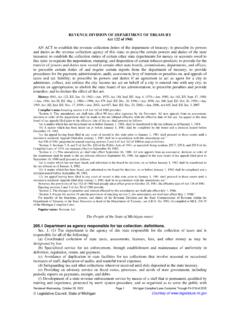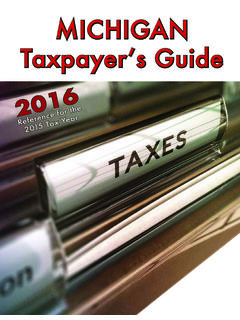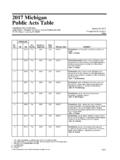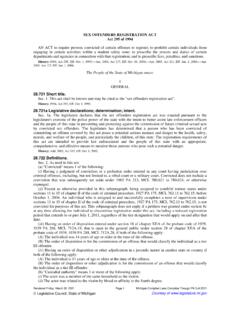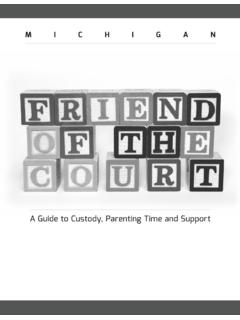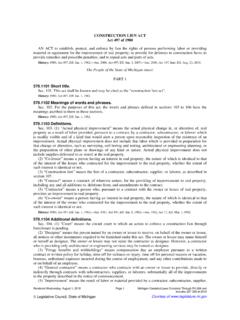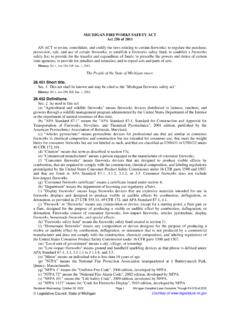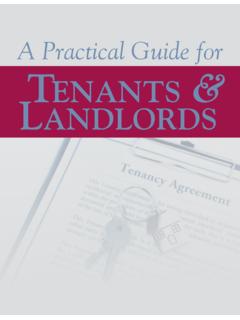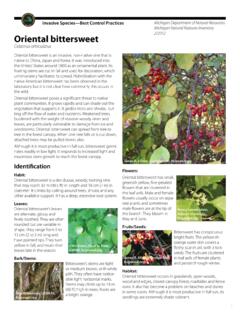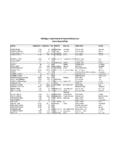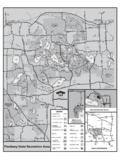Transcription of NATURAL RESOURCES AND ENVIRONMENTAL PROTECTION …
1 NATURAL RESOURCES AND ENVIRONMENTAL PROTECTION ACT (EXCERPT). Act 451 of 1994. PART 115. SOLID WASTE MANAGEMENT. Meanings of words and phrases. Sec. 11501. For purposes of this part, the words and phrases defined in sections 11502 to 11506 have the meanings ascribed to them in those sections. History: 1994, Act 451, Eff. Mar. 30, 1995. Compiler's note: For transfer of authority, powers, duties, functions, and responsibilities of the Waste Management Division to the Director of the Michigan Department of ENVIRONMENTAL Quality, see No. 1995-16, compiled at MCL of the Michigan Compiled Laws. Popular name: Act 451. Popular name: NREPA. Popular name: Solid Waste Act Definitions; A to C. Sec. 11502. (1) "Agronomic rate" means a rate that meets both of the following requirements: (a) Is generally recognized by the agricultural community or is calculated for a particular area of land to improve the physical nature of soil, such as structure, tilth, water retention, pH, or porosity, or to provide macronutrients or micronutrients in an amount not materially in excess of that needed by the crop, forest, or vegetation grown on the land.
2 (b) Takes into account and minimizes runoff of beneficial use by-products to surface water or neighboring properties, the percolation of excess nutrients beyond the root zone, and the liberation of metals from the soil into groundwater. (2) "Ashes" means the residue from the burning of wood, scrap wood, tires, biomass, wastewater sludge, fossil fuels including coal or coke, or other combustible materials. (3) "Beneficial use 1" means use as aggregate, road material, or building material that in ultimate use is or will be bonded or encapsulated by cement, limes, or asphalt. (4) "Beneficial use 2" means use as any of the following: (a) Construction fill at nonresidential property that meets all of the following requirements: (i) Is placed at least 4 feet above the seasonal groundwater table. (ii) Does not come into contact with a surface water body.
3 (iii) Is covered by concrete, asphalt pavement, or other material approved by the department. (iv) Does not exceed 4 feet in thickness, except for areas where exceedances are incidental to variations in the existing topography. This subparagraph does not apply to construction fill placed underneath a building or other structure. (b) Road base or soil stabilizer that does not exceed 4 feet in thickness except for areas where exceedances are incidental to variations in existing topography, is placed at least 4 feet above the seasonal groundwater table, does not come into contact with a surface water body, and is covered by concrete, asphalt pavement, or other material approved by the department. (c) Road shoulder material that does not exceed 4 feet in thickness except for areas where exceedances are incidental to variations in existing topography, is placed at least 4 feet above the seasonal groundwater table, does not come into contact with a surface water body, is sloped, and is covered by asphalt pavement, concrete, 6 inches of gravel, or other material approved by the department.
4 (5) "Beneficial use 3" means applied to land as a fertilizer or soil conditioner under part 85 or a liming material under 1955 PA 162, MCL to , if all of the following requirements are met: (a) The material is applied at an agronomic rate consistent with generally accepted agricultural and management practices. (b) The use, placement, or storage at the location of use does not do any of the following: (i) Violate part 55 or create a nuisance. (ii) Cause groundwater to no longer be fit for 1 or more protected uses as defined in R of the Michigan administrative code. (iii) Cause a violation of a part 31 surface water quality standard. (6) "Beneficial use 4" means any of the following uses: (a) To stabilize, neutralize, solidify, or otherwise treat waste for ultimate disposal at a facility licensed under this part or part 111.
5 Rendered Thursday, December 3, 2020 Page 1 Michigan Compiled Laws Complete Through PA 249 of 2020. Legislative Council, State of Michigan Courtesy of (b) To treat wastewater, wastewater treatment sludge, or wastewater sludge in compliance with part 31 or the federal water pollution control act, 33 USC 1251 to 1388, at a private or publicly owned wastewater treatment plant. (c) To stabilize, neutralize, solidify, cap, or otherwise remediate hazardous substances or contaminants as part of a response activity in compliance with part 201, part 213, or the comprehensive ENVIRONMENTAL response, compensation and liability act of 1980, 42 USC 9601 to 9657, or a corrective action in compliance with part 111 or the solid waste disposal act, 42 USC 6901 to 6992k. (d) As construction material at a landfill licensed under this part. (7) "Beneficial use 5" means blended with inert materials or with compost and used to manufacture soil.
6 (8) "Beneficial use by-product" means the following materials if the materials are stored for beneficial use or are used beneficially as specified and the requirements of section 11551(1) are met: (a) Coal bottom ash or wood ash used for beneficial use 3 or wood ash or coal ash, except for segregated flue gas desulfurization material, used for beneficial use 1, 2, or 4. (b) Pulp and paper mill ash used for beneficial use 1, 2, 3, or 4. (c) Mixed wood ash used for beneficial use 1, 2, 3, or 4. (d) Cement kiln dust used as a flue gas scrubbing reagent or for beneficial use 1, 2, 3, or 4. (e) Lime kiln dust used as a flue gas scrubbing reagent or for beneficial use 1, 2, 3, or 4. (f) Stamp sands used for beneficial use 1 or 2. (g) Foundry sand from ferrous or aluminum foundries used for beneficial use 1, 2, 3, 4, or 5. (h) Pulp and paper mill material, other than the following, used for beneficial use 3: (i) Rejects, from screens, cleaners, and mills dispersion equipment, containing more than de minimis amounts of plastic.
7 (ii) Scrap paper. (i) Spent media from sandblasting, with uncontaminated sand, newly manufactured, unpainted steel used for beneficial use 1 or 2. (j) Dewatered concrete grinding slurry from public transportation agency road projects used for beneficial use 1, 2, 3, or 4. (k) Lime softening residuals from the treatment and conditioning of water for domestic use or from a community water supply used for beneficial use 3 or 4. (l) Soil washed or otherwise removed from sugar beets that is used for beneficial use 3. (m) Segregated flue gas desulfurization material used for beneficial use 1 or 3. (n) Materials and uses approved by the department under section 11553(3) or (4). Approval of materials and uses by the department under section 11553(3) or (4) does not require the use of those materials by any governmental entity or any other person.
8 (9) "Beverage container" means an airtight metal, glass, paper, or plastic container, or a container composed of a combination of these materials, which, at the time of sale, contains 1 gallon or less of any of the following: (a) A soft drink, soda water, carbonated NATURAL or mineral water, or other nonalcoholic carbonated drink. (b) A beer, ale, or other malt drink of whatever alcoholic content. (c) A mixed wine drink or a mixed spirit drink. (10) "Bond" means a financial instrument executed on a form approved by the department, including a surety bond from a surety company authorized to transact business in this state, a certificate of deposit, a cash bond, an irrevocable letter of credit, insurance, a trust fund, an escrow account, or a combination of any of these instruments in favor of the department. The owner or operator of a disposal area who is required to establish a bond under another state statute or a federal statute may petition the department to allow such a bond to meet the requirements of this part.
9 The department shall approve a bond established under another state statute or a federal statute if the bond provides equivalent funds and access by the department as other financial instruments allowed by this subsection. (11) "Captive facility" means a landfill or coal ash impoundment that accepts for disposal, and accepted for disposal during the previous calendar year, only nonhazardous industrial waste generated only by the owner of the landfill or coal ash impoundment. (12) "Cement kiln dust" means particulate matter collected in air emission control devices serving Portland cement kilns. (13) "Certificate of deposit" means a negotiable certificate of deposit held by a bank or other financial institution regulated and examined by a state or federal agency, the value of which is fully insured by an agency of the United States government.
10 A certificate of deposit used to fulfill the requirements of this part shall be in the sole name of the department with a maturity date of not less than 1 year and shall be renewed not less than 60 days before the maturity date. An applicant who uses a certificate of deposit as a bond shall Rendered Thursday, December 3, 2020 Page 2 Michigan Compiled Laws Complete Through PA 249 of 2020. Legislative Council, State of Michigan Courtesy of receive any accrued interest on that certificate of deposit upon release of the bond by the department. (14) "Certified health department" means a city, county, or district department of health that is specifically delegated authority by the department to perform designated activities as prescribed by this part. (15) "Coal ash", subject to subsection (16), means any of the following: (a) Material recovered from systems for the control of air pollution from, or the noncombusted residue remaining after, the combustion of coal or coal coke, including, but not limited to, coal bottom ash, fly ash, boiler slag, flue gas desulfurization materials, or fluidized-bed combustion ash.
